Young scientists at the cutting edge: EIROforum prize winners Inspire article
Courtney Williams, winner of the CERN prize at the European Union Contest for Young Scientists 2009, reports on her experiences and those of the other EIROforum prize winners.

iStockphoto
In September 2009, in the Palais de la découverte in Paris, France, 132 young scientists aged 14 to 21 from Europe and beyond came together for the 21st European Union Contest for Young Scientists (EUCYS)w1 (see Rau, 2009). As part of the contest, participants presented original projects from all corners of science and competed for prizes while sampling some of Paris’s world-famous culture and getting to know each other. In addition to the main prizes from the European Union, a number of special prizes are awarded each year, including one-week visits to the EIROforumw2 institutes – a group of seven (now eight) research organisations around Europe, incorporating some of the world’s most exciting science. One of the lucky winners in 2009, I will share with you my experiences and those of four other winners of the EIROforum prizes that year.
Kristina Aare – studying bacteria in polluted water
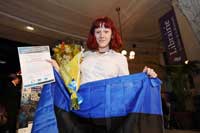
2009 EMBL prize at EUCYS
© European Communities,
1995-2009
“My interest in science started in secondary school, with a focus on biology and chemistry, which led to my successful participation in a number of national competitions in my home country of Estonia. My main passion is biochemistry, so I decided to work on the project which was to win the European Molecular Biology Laboratory [EMBL]w3 prize at EUCYS.”
Kristina’s research was dedicated to the problem of environmental pollution with oil. She studied the soil bacterium Pseudomonas putida, which has an extremely high tolerance of phenol, toluene and other toxic organic solvents found in oil.
She is really looking forward to her visit to EMBL in Heidelberg, Germany, and the insights this will provide her with.
Jake Martin – developing a new way of creating fuel
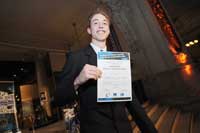
certificate
© European Communities,
1995-2009
Jake travelled halfway around the world to compete in EUCYS – from Auckland, New Zealand – and then again when he visited Culham, UK, for his visit to the European Fusion Development Agreement – Joint European Torus (EFDA-JET)w4.
Jake, now 19, has been competing in science fairs since he was 14. His EUCYS project consisted of a gasifier he built, which turns wood into a fuel gas that can run a normal petrol engine. Another output of his gasifier is biochar, a type of charcoal you get from pyrolising biomass.
The primary use of biochar is not as a fuel, however, but to take carbon dioxide out of the atmosphere. For his prize Jake visited the EFDA-JET facility, which itself is looking at alternative methods of generating energy: it is the only operational fusion experiment capable of actually producing fusion energy. He received advice and information from scientists working there, and learned more about how international co-operation plays a part in European science – a lot more so than in New Zealand.
Damian Steiger – building a miniature particle accelerator
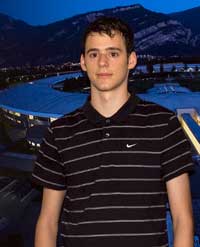
ESRF
Image courtesy of Chantal
Argoud / ESRF
“My project was to design and build a small cyclotron, small enough to fit on a desk. Therefore, I tried to apply as many new technologies as possible to the design of the first cyclotron, built in the 1930s. With my project I showed a way of building small cyclotrons with state-of-the-art technology and at low cost. In future some of the knowledge might be used to build small and compact cyclotrons for medical applications or materials research.”
For his prize, Damian went to the European Synchrotron Radiation Facility (ESRF)w5 and the Institut Laue Langevin (ILL)w6 at their joint campus in Grenoble, France, where he visited all the different laboratories and control rooms. “I enjoyed the visit to the reactor at ILL most,” he says. “The blue glow of the reactor due to the characteristic Cherenkov radiation was especially impressive. At the moment I am studying physics at ETH Zürich, Switzerland, and thanks to my visit to ESRF and ILL, I have a better idea of which field I want to work in afterwards.”
Julian Petrasch – tracking asteroids from the computer
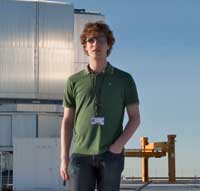
Paranal Observatory in Chile
Image courtesy of ESO
In his winning project, ‘Sky Alignment Simulator (SAMS) – improved determination of minor planet positions’, Julian Petrasch from Germany developed software to measure the positions of asteroids more precisely. The 17-year-old used the new software to pinpoint the positions of about 20 asteroids and two space probes. He reports that some publications on this topic from the Berlin Observatory have already used data processed with this new method.
As the winner of the ESO prize, Julian enjoyed the trip of a lifetime to two of ESO’sw8 observatories in Chile from 7 to 13 February 2010.
“It was amazing to walk between these giant telescopes and see how such large machines can be controlled and moved so precisely just by one person,” he said after his visit to Paranal Observatory. Julian, who became an amateur astronomer when he was only six years old, also feels deeply impressed by Chile, its nature, its enormous distances and the astonishing silence of the desert.
Courtney Williams – investigating underwater neutrino detection
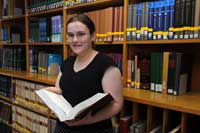
visit to the CERN library
Image courtesy of CERN
Unlike for many other contestants, EUCYS was my first international science fair. My project, ‘Listening for ghost particles: the acoustic cosmic ray neutrino experiment’, had two aspects: analysing background noise from an underwater neutrino detector, and simulating the acoustic pulses that high-energy neutrinos should make when they enter water.
EUCYS was a great experience and one of the best weeks I’ve ever had – quite apart from winning a prize.
As it happens, I was lucky enough to be awarded the CERNw7 prize: when I visited the institute this summer, I enjoyed learning about how all the different detectors work, as well as talking to people from different departments, including the press office, the director general and the engineers. My trip has intensified my desire to work in neutrino astrophysics and I’m really eager to go back to CERN!
Further EIROforum winners
The other EIROforum winner at EUCYS 2009 was Ana Shvetsova from Russia. Ana, who designed a vehicle to move on Venus, was awarded the European Space Agencyw9 prize. She explained her project in an online videow10.
With the 22nd EUCYS event, which took place in 2010 Lisbon, Portugal (see Rau, 2011), the number of young scientists visiting the EIROforum organisations continues to grow.
References
- Rau M (2009) Discoveries in Paris: the European Union Contest for Young Scientists. Science in School 13: 6-9. www.scienceinschool.org/2009/issue13/eucys09
- Rau M (2011) Young minds in science: the European Union Contest for Young Scientists 2010. Science in School 18: 13-16. www.scienceinschool.org/2011/issue18/eucys2010
Web References
- w1 – Find out more about the European Union Contest for Young Scientists on their website: http://ec.europa.eu/research/youngscientists
- For a preview of the 2011 contest to be held in Helsinki, Finland, see: http://eucys2011.tek.fi
- w2 – To learn more about EIROforum and its research organisations, see: www.eiroforum.org
- w3 – The EMBL website can be found here: www.embl.org
- w4 – To find out more about EFDA-JET, see: www.jet.efda.org
- w5 – Visit the website of ESRF for more information: www.esrf.eu
- w6 – To learn more about ILL, see: www.ill.eu
- w7 – For more information about CERN, see: www.cern.ch
- w8 – Learn more about ESO online: www.eso.org
- w9 – Find more information on ESA on their website: www.esa.int
- w10 – To watch Ana Shvetsova explain her project (in English with French subtitles) see the www.universcience.tv website or use the direct link: http://tinyurl.com/5vy9yub
Resources
- To read Courtney’s full report on her stay at CERN and her experience as a EUCYS participant, see her blog http://ysjournal.com/2011/09/my-week-at-cern/
- Courtney describes how she came to be interested in physics in an article in Symmetry www.symmetrymagazine.org/cms/?pid=1000859
- To learn more about the individual EIROforum institutes, see:
- EIROforum (2010) EIROforum: introducing the publisher of Science in School. Science in School 15: 8-17. www.scienceinschool.org/2010/issue15/eiroforum
Institutions






